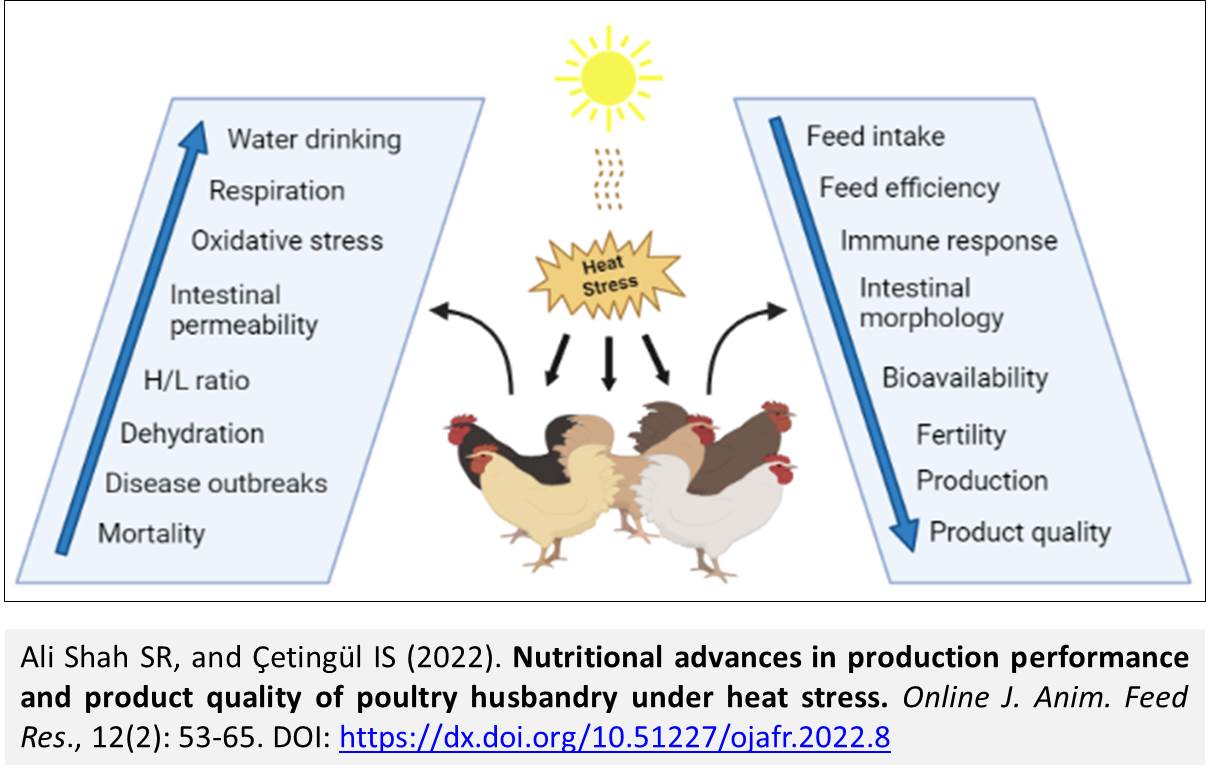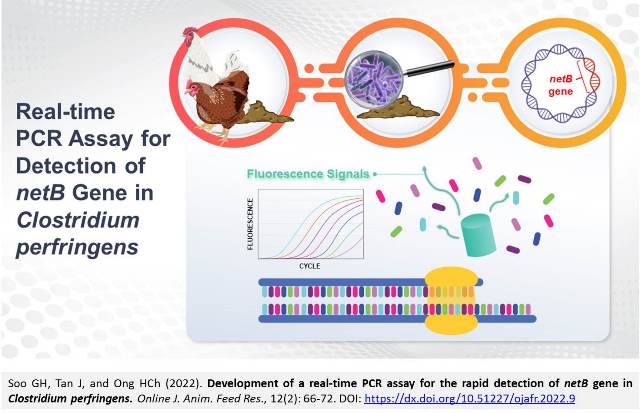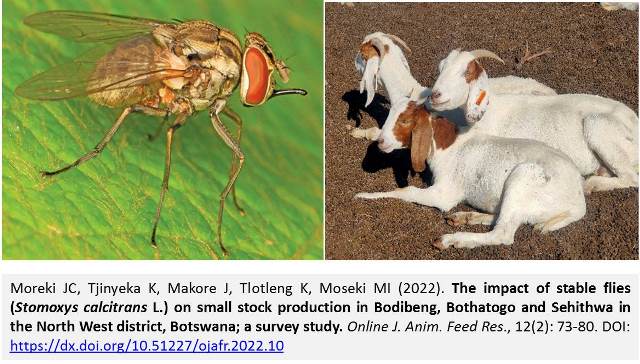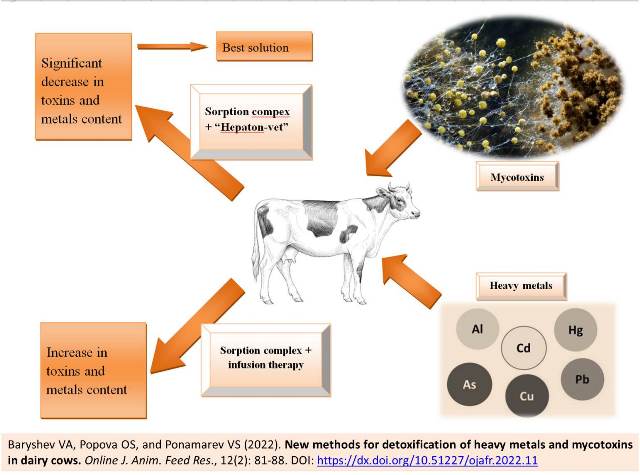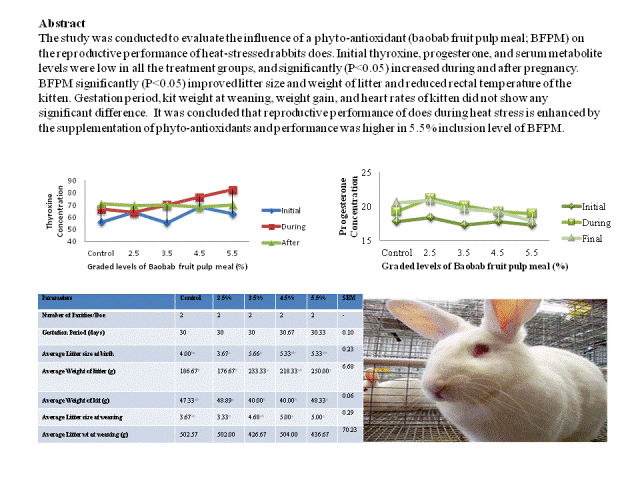Previous issue | Next issue | Archive
![]() Volume 12 (2); March 25, 2022 [Booklet] [EndNote XML for Agris]
Volume 12 (2); March 25, 2022 [Booklet] [EndNote XML for Agris]
|
|
Nutritional advances in production performance and product quality of poultry husbandry under heat stress
Ali Shah SR, and Çetingül IS.
Online J. Anim. Feed Res., 12(2): 53-65, 2022; pii: S222877012200008-12
DOI: https://dx.doi.org/10.51227/ojafr.2022.8
Abstract
The objective of this review is to explore the nutritional additives to combat heat stress in high production targeted fowls. Many diseases and stress dynamics are liable for heavy mortality nowadays. High production targets and heat stress initiate free radical injuries and gastrointestinal oxidative insults resulting in poor bioavailability and feed efficiency. Accordingly, the quality of the eggs and meat is compromised along with the bird’s health. Dietary schemes and relevant feed formulation with the provision of vital elements like selenium, zinc, calcium, vitamin E, vitamin C, vitamin A, electrolytes, essential amino acids, and plant extracts can conflict with all sorts of stress in birds and improve the immune system. The occurrence of many contagious diseases, nervous ailments, and metabolic syndromes can be decreased via appropriate feeding routines. It will not only control the bird’s health but also increase the quality and market value of the products and consumer satisfaction. Scientists have struggled to prevent immuno-depression, egg and meat quality impairments by dietary influences. Poultry welfare is facing many problems currently which should be properly coped with innovative nutritional maneuvers. This review anticipates illuminating the probable nutritional approaches to manage stress in poultry birds.
Keywords: Heat stress, Poultry, Electrolytes, Phytogenic, Product quality
[Full text-PDF] [Scopus] [ePub] [Export from ePrint] [Export citation to RIS & EndNote] [How to Cite]
|
|
Development of a real-time PCR assay for the rapid detection of netB gene in Clostridium perfringens
Soo GH, Tan J, and Ong HCh.
Online J. Anim. Feed Res., 12(2): 66-72, 2022; pii: S222877012200009-12
DOI: https://dx.doi.org/10.51227/ojafr.2022.9
Abstract
Necrotic enteritis (NE) has a huge economic impact in the poultry industry. Numerous studies have shown that necrotic enteritis toxin B (netB) is a key virulence factor in Clostridium perfringens strains that cause NE in chickens. Early detection of netB in C. perfringens is important to circumvent the spread of NE. In this study, we developed a novel combinatorial approach involving (i) a commercial 2-step DNA extraction kit and (ii) a real-time polymerase chain reaction (qPCR) for the detection of netB-positive C. perfringens in fecal samples. Melt curve analysis and specificity test demonstrated 100% specificity without any cross-reactivity in other bacterial species with a limit of detection of 102 cfu/g. Field validation was subsequently conducted on nine fecal composites collected from different layer houses at two commercial farms, leading to successful detection of four netB positive samples. The study presented a rapid diagnostic qPCR assay involving a 2-step DNA extraction protocol to screen for C. perfringens carrying netB gene in chicken fecal samples.
Keywords: Clostridium perfringens; Necrotic enteritis; netB gene; Poultry; Real-time PCR
[Full text-PDF] [Scopus] [ePub] [Export from ePrint] [Export citation to RIS & EndNote] [How to Cite]
|
|
The impact of stable flies (Stomoxys calcitrans L.) on small stock production in Bodibeng, Bothatogo and Sehithwa in the North West district, Botswana; a survey study
Moreki JC, Tjinyeka K, Makore J, Tlotleng K, Moseki MI.
Online J. Anim. Feed Res., 12(2): 73-80, 2022; pii: S222877012200010-12
DOI: https://dx.doi.org/10.51227/ojafr.2022.10
Abstract
Stable fly, Stomoxys calcitrans L. (Diptera: Muscidae) is a globally recognized livestock pest of economic importance, which also attacks wild animals, pets and humans. These flies frequently feed on the forelegs of animals and can cause significant production losses and severe animal health and welfare concerns. This study investigated the impact of stable flies on small stock (sheep and goats) production and documented control measures adopted by farmers in Sehithwa, Bodibeng and Bothatogo villages in the North West District of Botswana. Simple Random Sampling was used to select 90 respondents in the study area. Data on demographic characteristics (i.e., age, sex, marital and educational status of the respondents), control measures against stable flies, time stable flies appeared, factors contributing to abundance of stable flies, and the role of government and private sector in the control of stable flies were collected and analysed using SAS. The Chi-square test of goodness of fit was used to show the unequal distribution of the frequencies of respondents among the categories for each variable. Results showed that wood smoking (53.33%) was the common control measure against stable flies followed by migration to unaffected areas (35.55%) and dipping (11.11%). Feeding activity of stable flies reached its peak in the evening (58.89%) followed by morning (31.11%), afternoon (6.67%) and the least was night (3.33%). Eighty-seven percent of respondents mentioned that stable fly contributed to poverty, starvation (16.67%) and loss of income (13.33%). It is concluded that stable flies affect livestock productivity and people’ livelihood; hence the need to adopt effective control measures. Control measures against these flies will be more effective when applied in the evening and morning.
Keywords: Control measures, Economic losses, Livestock pest, Small stock, Stable flies.
[Full text-PDF] [Scopus] [ePub] [Export from ePrint] [Export citation to RIS & EndNote] [How to Cite]
|
|
New methods for detoxification of heavy metals and mycotoxins in dairy cows
Baryshev VA, Popova OS, and Ponamarev VS.
Online J. Anim. Feed Res., 12(2): 81-88, 2022; pii: S222877012200011-12
DOI: https://dx.doi.org/10.51227/ojafr.2022.11
Abstract
Among the many environmental and industrial factors that adversely affect the soil, the pollution with heavy metals and mycotoxins occupies a special place in livestock breeding. This study aimed to demonstrate methods of treating and pharmacological correction of a toxic state intensified by heavy metals and mycotoxins in cattle using native drug as mycotoxin-deactivating feed additive. A total of 20 highly productive Holstein cows aged 3-4 years were divided into 2 groups, based on clinical and biochemical parameters. The experimental group (n=10) fed a diet supplemented with 4% sorption complex and a drug based on Silybum marianum and ursodeoxycholic acid as a hepatoprotector named “Hepaton-vet”. The control group (n=10) was injected with a complex of sorbents (consisting of perlite, vermiculite, and polyphepan in equal proportions) at a dose of 4% of the daily intake of food, and the rest of the treatment was carried out with the help of daily infusion therapy. So in the feed samples, only the T-2 and Deoxynivalenol (DON) indicators exceeded the normal value by 1.66% and, 3%, respectively. Thus, the practical efficiency concerning T-2, aflatoxin and Deoxynivalenol were to 100%, 86%, 18%, respectively. Cadmium in compound feed was lower by 44%, in comparison with the maximum permissible concentration, followed by 53.3% in hay and 78% in silage. The amount of lead in compound feed and silage was 78%, and it was 35% in the hay. In conclusion, the use of a complex of sorbents, together with newly developed component “Hepaton-vet”, led to positive results, allowing for the identification of several effects that influenced the metabolic processes in the liver, which was confirmed by the results of morpho-biochemical blood tests and clinical diagnostics of the animals' condition.
Keywords: Cattle, Heavy metals, Mycotoxins, Silage, Sorption complex.
[Full text-PDF] [Scopus] [ePub] [Export from ePrint] [Export citation to RIS & EndNote] [How to Cite]
|
|
Effect of supplementation of phyto-antioxidant (baobab fruit pulp meal) on reproductive performance of rabbit does during heat stress
Anoh KU, Paul JN and Amu UM.
Online J. Anim. Feed Res., 12(2): 89-96, 2022; pii: S222877012200012-12
DOI: https://dx.doi.org/10.51227/ojafr.2022.12
Abstract
A study was conducted to evaluate the influence of a phyto-antioxidant (baobab fruit pulp meal; BFPM) on the reproductive performance of heat-stressed rabbits does. A total of 50 New Zealand White crosses adult rabbit does of 12 months old were used in the present study. The rabbits were randomly allotted into five experimental treatment groups, with ten rabbits per treatment in a completely randomized design. The rabbits were fed diets supplemented with graded levels (0.0%, 2.5%, 3.5%, 4.5% and 5.5%) of BFPM. Parameters monitored were thyroxin and progesterone secretion, serum metabolites, reproductive traits, and physiological performance of the kitten. Initial thyroxin, progesterone, and serum metabolite levels were low in all the treatment groups, and significantly increased during and after pregnancy. BFPM significantly improved litter size and weight of litter and reduced rectal temperature of the kitten. Gestation period, kit weight at weaning, weight gain, and heart rates of kitten did not show any significant difference. It was concluded that reproductive performance of does during heat stress is enhanced by the supplementation of phyto-antioxidants and performance was higher in 5.5% inclusion level of BFPM.
Keywords: Antioxidant, Gestation, Heat stress, Rabbit, Reproductive hormones.
[Full text-PDF] [Scopus] [ePub] [Export from ePrint] [Export citation to RIS & EndNote] [How to Cite]
|
|
Nutritional value and in situ degradability of selected forages, browse trees and agro industrial by-products
Terefe G, Faji M and Mengistu G.
Online J. Anim. Feed Res., 12(2): 97-102, 2022; pii: S222877012200013-12
DOI: https://dx.doi.org/10.51227/ojafr.2022.13
Abstract
The in situ dry matter and crude protein degradability of grasses, legumes, browse trees and agro industrial by products was evaluated by the fistulated bulls (Boran × Holstein-Friesian with mean body weight 580 kg and age= 29±3 months). The lower (P < 0.05) crude protein content was reported in bracharia grasses than the other grasses. The higher (P < 0.05) washing loss in bracharia and Rhodes grasses and the better (P < 0.05) potential and effective degradability for dry matter (DM) and crude protein (CP) was observed in desho grass compared with other grasses. The content of crude protein, relative feed value and potential DM degradability were higher (P < 0.05) in Sesbania than Pigeon pea and tree lucerne. Potential and effective DM degradability was better (P < 0.05) in tree lucerne than the other browses. Acacia nilotica and Wanza (Cordia africana) had the greater (P < 0.05) washes loss, potential and effective degradability for dry matter and crude protein than the other browse trees. Cactus and Shola had the highest (P < 0.05) undegradable protein than Acacia nilotica and Wanza. The two energy source feeds (maize and wheat bran) had the greater (P < 0.05) potential and effective dry matter degradability than the other by products. The rumen undegradable protein was higher in vetch than lablab. The in situ dry matter degradability values obtained in this study can be useful to identifying the best materials used ruminant feeds.
Keywords: By-products, Dry matter, Forage, Rumen degradability, Bulls.
[Full text-PDF] [Scopus] [ePub] [Export from ePrint] [Export citation to RIS & EndNote] [How to Cite]
Previous issue | Next issue | Archive
This work is licensed under a Creative Commons Attribution 4.0 International License (CC BY 4.0).![]()
| < Prev | Next > |
|---|

